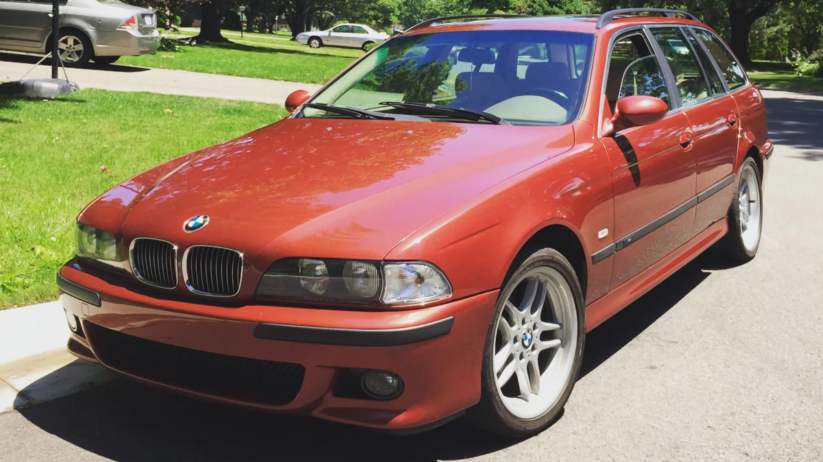My girlfriend is a therapist. Shortly before graduating with her Master’s degree, she decided to start shopping for a new car—or, like her boyfriend, a new old car. As a wagon aficionado myself, I was overjoyed when she told me that she wanted a BMW wagon. Vowing to move heaven and Earth to find her the very best BMW wagon I could, I wound up settling on the nicest E39 540i Touring we could get our hands on.
For her, it was love at first sight. Sienna Red over beige leather, this particular 540i was the pride and joy of a BMW mechanic, who meticulously kept up with maintenance, as evidenced by the fresh tires, brakes, suspension, and clean engine bay. The dreaded timing-chain guides had allegedly been replaced recently. Whether or not this was true is a moot point, because the external timing-chain tensioner failed shortly after purchase. Fast-forward two two years and several thousand dollars in attempted repairs later, and the car is still not quite right. A full timing-chain service, new VANOS units, clearing adaptations, sacrificing orphans to Moloch—nothing will make this car happy.
Giving up on diagnosing the car the usual way—Bentley manual, forums (USE THE SEARCH!), setting piles of money on fire, the Necronomicon—I decided to try something new: I asked her to have a therapy session with the car. I figured that our wayward E39 needed some diagnostics that could not be provided by a BMW GS-1 computer.
The Diagnostic and Statistical Manual of Mental Disorders, or DSM-5, is used by mental-health professionals (like my girlfriend) to diagnose—and treat—various mental-health issues, from fear of heights (acrophobia) to stress caused by prior traumatic events (PTSD). Think of it as a Bentley workshop manual for the human brain. The DSM-5 outlines Borderline Personality Disorder (BPD) as “a pervasive pattern of instability of interpersonal relationships.” According to the DSM-5, five or more of the following symptoms must be present for a positive diagnosis. Let’s go through them one by one.
- Fear of abandonment. Surprisingly, the car is perfectly content to sit for extended periods of time without discharging the battery, but the scan tool always seems to reveal mysterious new codes despite the fact that nothing besides the weather has changed since the last time it was driven. Check.
- Unstable and intense relationships. Hoo boy! When it works—a very rare occasion indeed—it’s absolutely wonderful to drive. The power from the M62 V8 is intoxicating. The chassis is really wonderful, entertaining, and compliant, while still providing a smooth and supple ride. And then it happens. “Honey, what’s wrong?” Cue the orange illumination of the check-engine light and that evil “ding” from the dashboard, as if the car is trying to say “nothing” passive-aggressively.
- Unstable self-image. The previous owner, at a great expense, replaced the bumpers, side skirts, mirrors, wheels, and door sills with factory M5 pieces, and I have to admit that the faux-M5 look of this particular wagon attracted us to it far more than the stock body kit and wheels would have. My kryptonite used to be art students with dyed hair, tattoos, and piercings; now it’s staggered Style 37 M-Parallel wheels. God help me.
- Impulsive behavior. While the excellent handling of the E39 chassis is nothing short of predictable, I can’t say the same for the rest of the car. I’m never quite sure what will happen next. Transmission control unit? Cooling system? Cup-holders again? Owning an E39 540i is like dating the woman of your dreams, except she randomly wakes you up in the middle of the night holding a knife to your throat.
- Destructive behavior. Shortly after getting the car back for the second or third time after I’d all but given up on trying to fix it myself, Beth and I took her young niece and nephew out to dinner. While merging onto the highway, the 540i decided that the failing mass-air-flow sensor was a critical situation and cut the power, leaving us at the mercy of a pair of eighteen-heelers bearing down on us in excess of 60 miles per hour. We’re going to go ahead and check this box, too.
- Mood instability. Nothing makes this car happy. No matter what gifts I lay at its feet—OEM replacement parts, top-quality oil, LED interior lights, Euro taillights, my very sanity—nothing will ever be good enough for this car. It will initially reward me with one, perhaps even two days of uninterrupted service, and then it will hate me again. What have I ever done besides love you, E39? Love, love will tear us apart, again.
- Feelings of emptiness. The E39 540i Touring weighs over 3,800 pounds, and is powered by a 4.4-liter M62 V8 good for nearly 300 horsepower. The fuel tank has a capacity of 18.5 gallons. Premium, naturally. Next!
- Bouts of intense anger. I’m not sure what the E39’s rear tires or my bank account did to be on the receiving end of such unmitigated rage. It’s entirely undeserved and wholly uncalled for. We should start a support group. Oh, wait, it already exists: It’s called the BMW Car Club of America.
- Paranoia. Finally, a symptom the car doesn’t exhibit. We, the hapless owners, on the other hand, experience paranoia on a regular basis. We generally avoid eye contact, and if we find ourselves on the receiving end of a bonus or a month with a third paycheck, we ensure that the car is safely tucked away in the garage under its cover before we share the news with each other in hushed, excited tones.
So there you have it. Without a doubt, our BMW has Borderline Personality Disorder. I’m glad to finally know what’s really going on, and hopefully, with some therapy, we’ll be able to move on with our lives and learn to love again.
I’d like to take this opportunity to let you know that our 1999 BMW 540i Touring is for sale. It’s in excellent shape, it’s breathtakingly gorgeous, and it drives great. You’re going to love it, trust me.—Cam VanDerHorst






















